Mass Tourism in Pompeii: Problems, Solutions, and Analysis
VerifiedAdded on 2022/08/20
|8
|1987
|21
Report
AI Summary
This report provides an in-depth analysis of the challenges posed by mass tourism in Pompeii. It begins with an introduction to the concept of mass tourism and its impact, specifically focusing on Pompeii as a case study. The report explores the negative consequences of mass tourism in Pompeii, including the excessive use of resources, pollution of air, water, and land, the destruction of privacy for residents, and cultural degradation. It then presents potential solutions and improvement strategies, drawing parallels with the sustainable practices implemented at the Grand Canyon National Park. These solutions include attracting tourists during the lean season, providing government support to residents, dispersing hospitality facilities, promoting respect for local culture, implementing community improvement action plans, and utilizing digital media to share information. The report concludes by emphasizing the importance of adopting these solutions to mitigate the adverse effects of mass tourism and preserve Pompeii for future generations. The report also provides an extensive bibliography of the sources used.
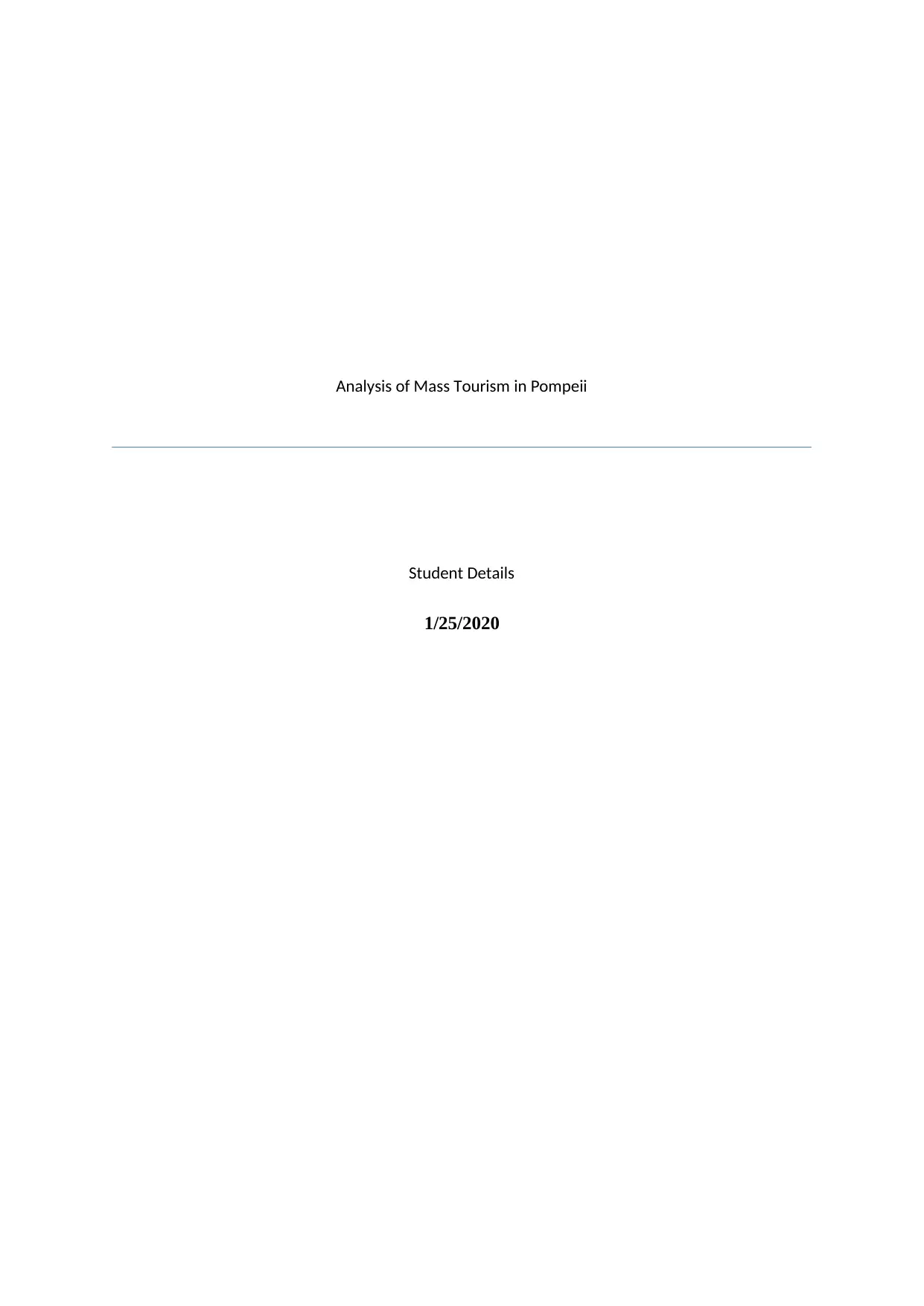
Analysis of Mass Tourism in Pompeii
Student Details
1/25/2020
Student Details
1/25/2020
Paraphrase This Document
Need a fresh take? Get an instant paraphrase of this document with our AI Paraphraser
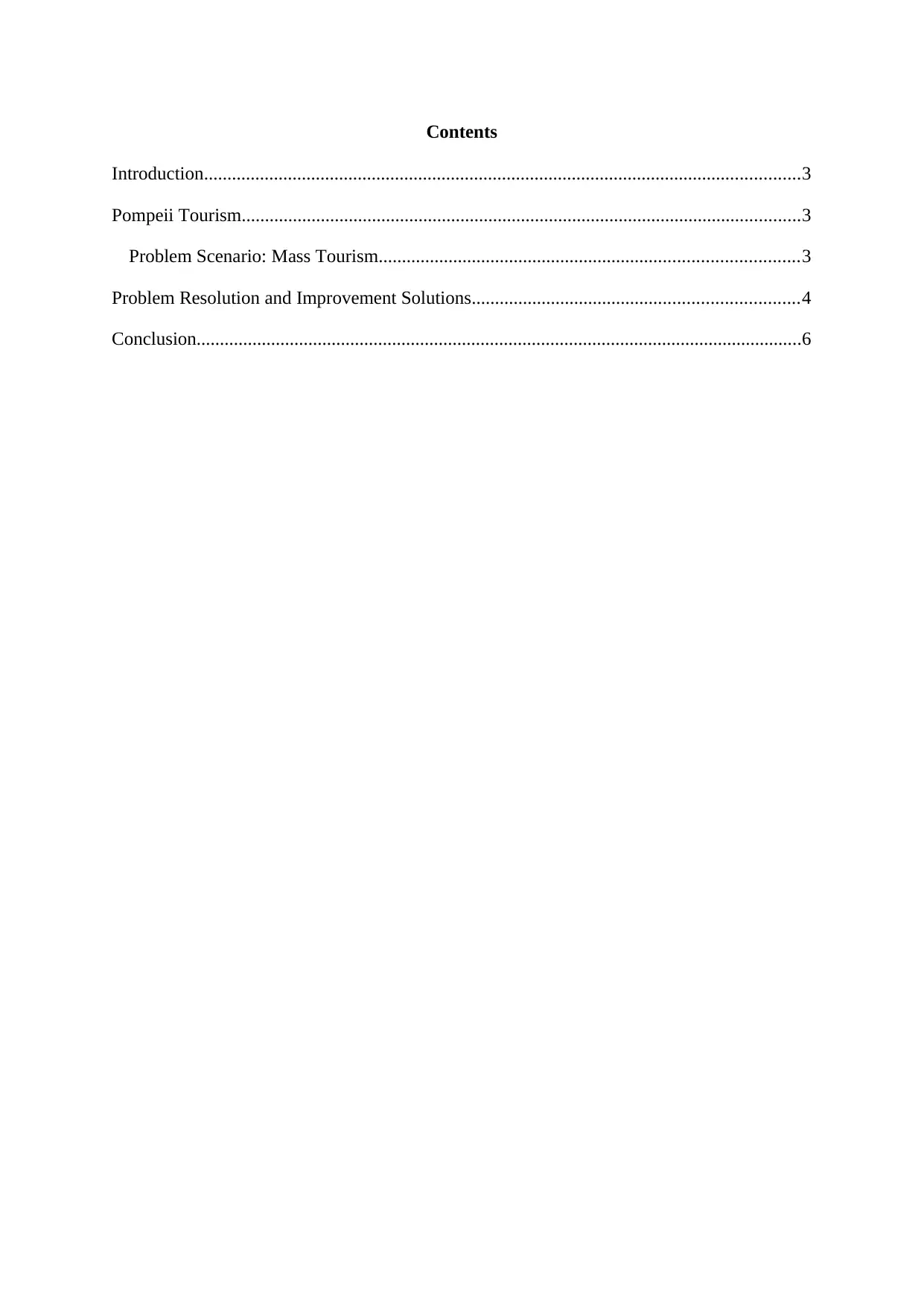
Contents
Introduction................................................................................................................................3
Pompeii Tourism........................................................................................................................3
Problem Scenario: Mass Tourism..........................................................................................3
Problem Resolution and Improvement Solutions......................................................................4
Conclusion..................................................................................................................................6
Introduction................................................................................................................................3
Pompeii Tourism........................................................................................................................3
Problem Scenario: Mass Tourism..........................................................................................3
Problem Resolution and Improvement Solutions......................................................................4
Conclusion..................................................................................................................................6
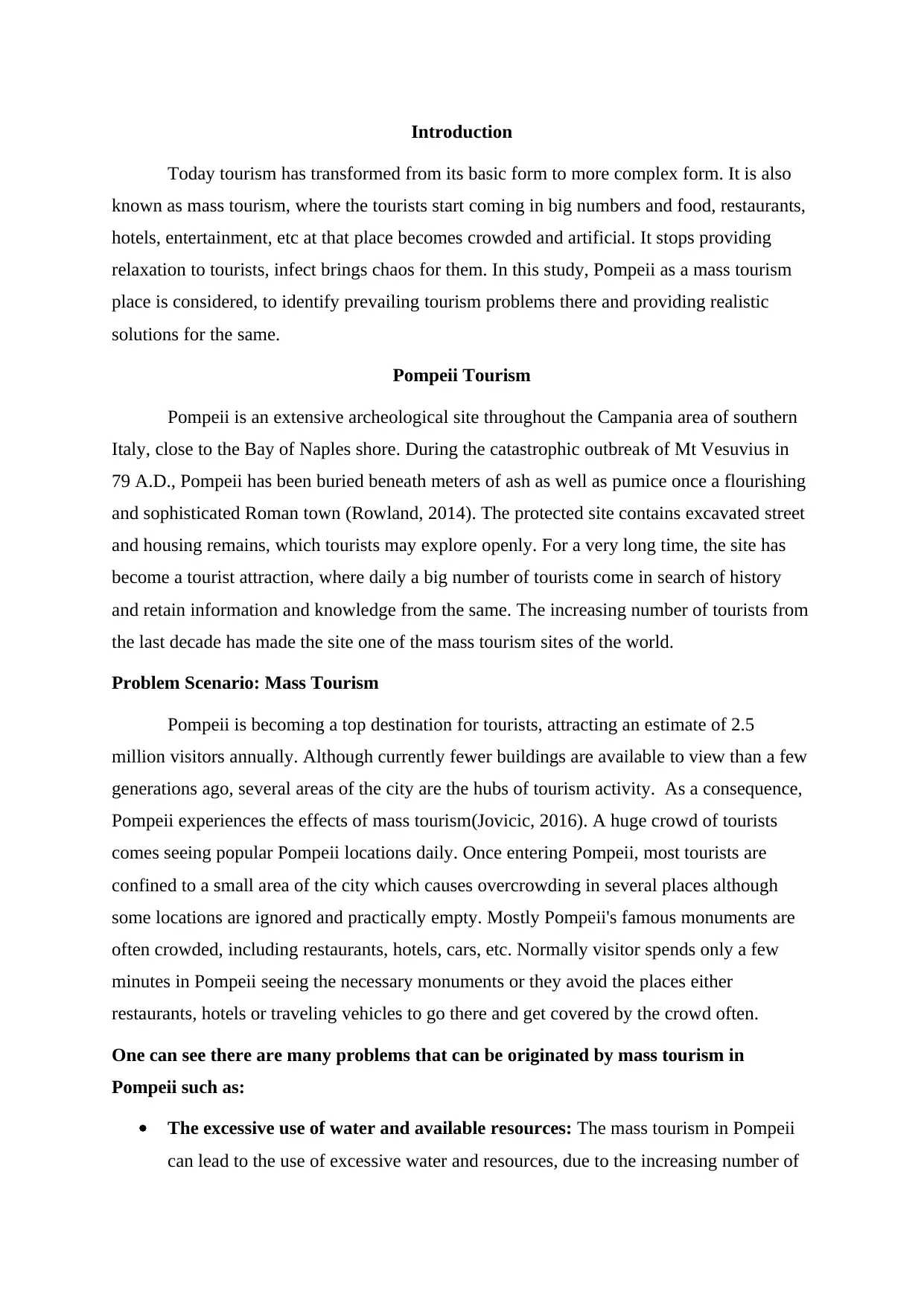
Introduction
Today tourism has transformed from its basic form to more complex form. It is also
known as mass tourism, where the tourists start coming in big numbers and food, restaurants,
hotels, entertainment, etc at that place becomes crowded and artificial. It stops providing
relaxation to tourists, infect brings chaos for them. In this study, Pompeii as a mass tourism
place is considered, to identify prevailing tourism problems there and providing realistic
solutions for the same.
Pompeii Tourism
Pompeii is an extensive archeological site throughout the Campania area of southern
Italy, close to the Bay of Naples shore. During the catastrophic outbreak of Mt Vesuvius in
79 A.D., Pompeii has been buried beneath meters of ash as well as pumice once a flourishing
and sophisticated Roman town (Rowland, 2014). The protected site contains excavated street
and housing remains, which tourists may explore openly. For a very long time, the site has
become a tourist attraction, where daily a big number of tourists come in search of history
and retain information and knowledge from the same. The increasing number of tourists from
the last decade has made the site one of the mass tourism sites of the world.
Problem Scenario: Mass Tourism
Pompeii is becoming a top destination for tourists, attracting an estimate of 2.5
million visitors annually. Although currently fewer buildings are available to view than a few
generations ago, several areas of the city are the hubs of tourism activity. As a consequence,
Pompeii experiences the effects of mass tourism(Jovicic, 2016). A huge crowd of tourists
comes seeing popular Pompeii locations daily. Once entering Pompeii, most tourists are
confined to a small area of the city which causes overcrowding in several places although
some locations are ignored and practically empty. Mostly Pompeii's famous monuments are
often crowded, including restaurants, hotels, cars, etc. Normally visitor spends only a few
minutes in Pompeii seeing the necessary monuments or they avoid the places either
restaurants, hotels or traveling vehicles to go there and get covered by the crowd often.
One can see there are many problems that can be originated by mass tourism in
Pompeii such as:
The excessive use of water and available resources: The mass tourism in Pompeii
can lead to the use of excessive water and resources, due to the increasing number of
Today tourism has transformed from its basic form to more complex form. It is also
known as mass tourism, where the tourists start coming in big numbers and food, restaurants,
hotels, entertainment, etc at that place becomes crowded and artificial. It stops providing
relaxation to tourists, infect brings chaos for them. In this study, Pompeii as a mass tourism
place is considered, to identify prevailing tourism problems there and providing realistic
solutions for the same.
Pompeii Tourism
Pompeii is an extensive archeological site throughout the Campania area of southern
Italy, close to the Bay of Naples shore. During the catastrophic outbreak of Mt Vesuvius in
79 A.D., Pompeii has been buried beneath meters of ash as well as pumice once a flourishing
and sophisticated Roman town (Rowland, 2014). The protected site contains excavated street
and housing remains, which tourists may explore openly. For a very long time, the site has
become a tourist attraction, where daily a big number of tourists come in search of history
and retain information and knowledge from the same. The increasing number of tourists from
the last decade has made the site one of the mass tourism sites of the world.
Problem Scenario: Mass Tourism
Pompeii is becoming a top destination for tourists, attracting an estimate of 2.5
million visitors annually. Although currently fewer buildings are available to view than a few
generations ago, several areas of the city are the hubs of tourism activity. As a consequence,
Pompeii experiences the effects of mass tourism(Jovicic, 2016). A huge crowd of tourists
comes seeing popular Pompeii locations daily. Once entering Pompeii, most tourists are
confined to a small area of the city which causes overcrowding in several places although
some locations are ignored and practically empty. Mostly Pompeii's famous monuments are
often crowded, including restaurants, hotels, cars, etc. Normally visitor spends only a few
minutes in Pompeii seeing the necessary monuments or they avoid the places either
restaurants, hotels or traveling vehicles to go there and get covered by the crowd often.
One can see there are many problems that can be originated by mass tourism in
Pompeii such as:
The excessive use of water and available resources: The mass tourism in Pompeii
can lead to the use of excessive water and resources, due to the increasing number of
⊘ This is a preview!⊘
Do you want full access?
Subscribe today to unlock all pages.

Trusted by 1+ million students worldwide
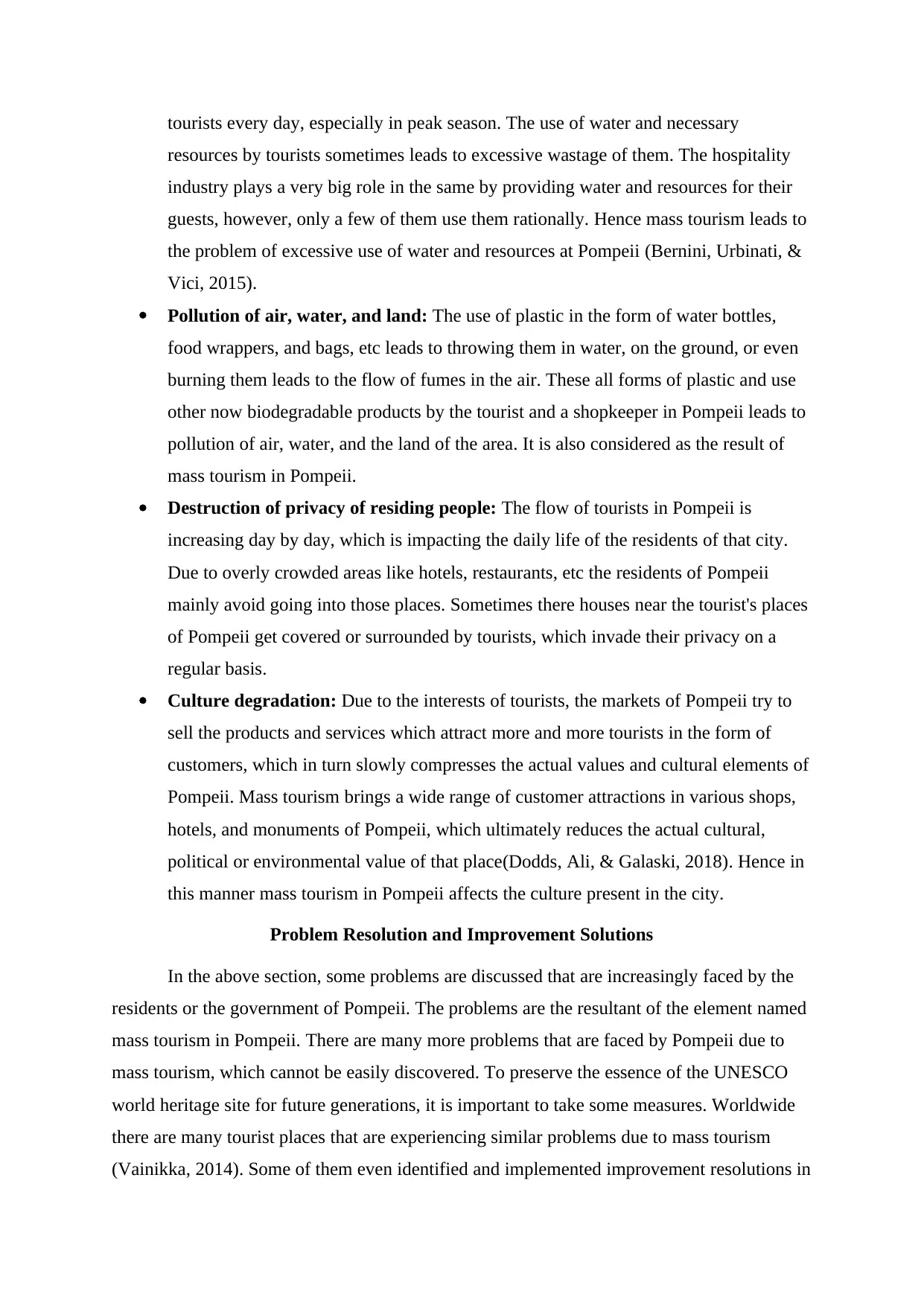
tourists every day, especially in peak season. The use of water and necessary
resources by tourists sometimes leads to excessive wastage of them. The hospitality
industry plays a very big role in the same by providing water and resources for their
guests, however, only a few of them use them rationally. Hence mass tourism leads to
the problem of excessive use of water and resources at Pompeii (Bernini, Urbinati, &
Vici, 2015).
Pollution of air, water, and land: The use of plastic in the form of water bottles,
food wrappers, and bags, etc leads to throwing them in water, on the ground, or even
burning them leads to the flow of fumes in the air. These all forms of plastic and use
other now biodegradable products by the tourist and a shopkeeper in Pompeii leads to
pollution of air, water, and the land of the area. It is also considered as the result of
mass tourism in Pompeii.
Destruction of privacy of residing people: The flow of tourists in Pompeii is
increasing day by day, which is impacting the daily life of the residents of that city.
Due to overly crowded areas like hotels, restaurants, etc the residents of Pompeii
mainly avoid going into those places. Sometimes there houses near the tourist's places
of Pompeii get covered or surrounded by tourists, which invade their privacy on a
regular basis.
Culture degradation: Due to the interests of tourists, the markets of Pompeii try to
sell the products and services which attract more and more tourists in the form of
customers, which in turn slowly compresses the actual values and cultural elements of
Pompeii. Mass tourism brings a wide range of customer attractions in various shops,
hotels, and monuments of Pompeii, which ultimately reduces the actual cultural,
political or environmental value of that place(Dodds, Ali, & Galaski, 2018). Hence in
this manner mass tourism in Pompeii affects the culture present in the city.
Problem Resolution and Improvement Solutions
In the above section, some problems are discussed that are increasingly faced by the
residents or the government of Pompeii. The problems are the resultant of the element named
mass tourism in Pompeii. There are many more problems that are faced by Pompeii due to
mass tourism, which cannot be easily discovered. To preserve the essence of the UNESCO
world heritage site for future generations, it is important to take some measures. Worldwide
there are many tourist places that are experiencing similar problems due to mass tourism
(Vainikka, 2014). Some of them even identified and implemented improvement resolutions in
resources by tourists sometimes leads to excessive wastage of them. The hospitality
industry plays a very big role in the same by providing water and resources for their
guests, however, only a few of them use them rationally. Hence mass tourism leads to
the problem of excessive use of water and resources at Pompeii (Bernini, Urbinati, &
Vici, 2015).
Pollution of air, water, and land: The use of plastic in the form of water bottles,
food wrappers, and bags, etc leads to throwing them in water, on the ground, or even
burning them leads to the flow of fumes in the air. These all forms of plastic and use
other now biodegradable products by the tourist and a shopkeeper in Pompeii leads to
pollution of air, water, and the land of the area. It is also considered as the result of
mass tourism in Pompeii.
Destruction of privacy of residing people: The flow of tourists in Pompeii is
increasing day by day, which is impacting the daily life of the residents of that city.
Due to overly crowded areas like hotels, restaurants, etc the residents of Pompeii
mainly avoid going into those places. Sometimes there houses near the tourist's places
of Pompeii get covered or surrounded by tourists, which invade their privacy on a
regular basis.
Culture degradation: Due to the interests of tourists, the markets of Pompeii try to
sell the products and services which attract more and more tourists in the form of
customers, which in turn slowly compresses the actual values and cultural elements of
Pompeii. Mass tourism brings a wide range of customer attractions in various shops,
hotels, and monuments of Pompeii, which ultimately reduces the actual cultural,
political or environmental value of that place(Dodds, Ali, & Galaski, 2018). Hence in
this manner mass tourism in Pompeii affects the culture present in the city.
Problem Resolution and Improvement Solutions
In the above section, some problems are discussed that are increasingly faced by the
residents or the government of Pompeii. The problems are the resultant of the element named
mass tourism in Pompeii. There are many more problems that are faced by Pompeii due to
mass tourism, which cannot be easily discovered. To preserve the essence of the UNESCO
world heritage site for future generations, it is important to take some measures. Worldwide
there are many tourist places that are experiencing similar problems due to mass tourism
(Vainikka, 2014). Some of them even identified and implemented improvement resolutions in
Paraphrase This Document
Need a fresh take? Get an instant paraphrase of this document with our AI Paraphraser
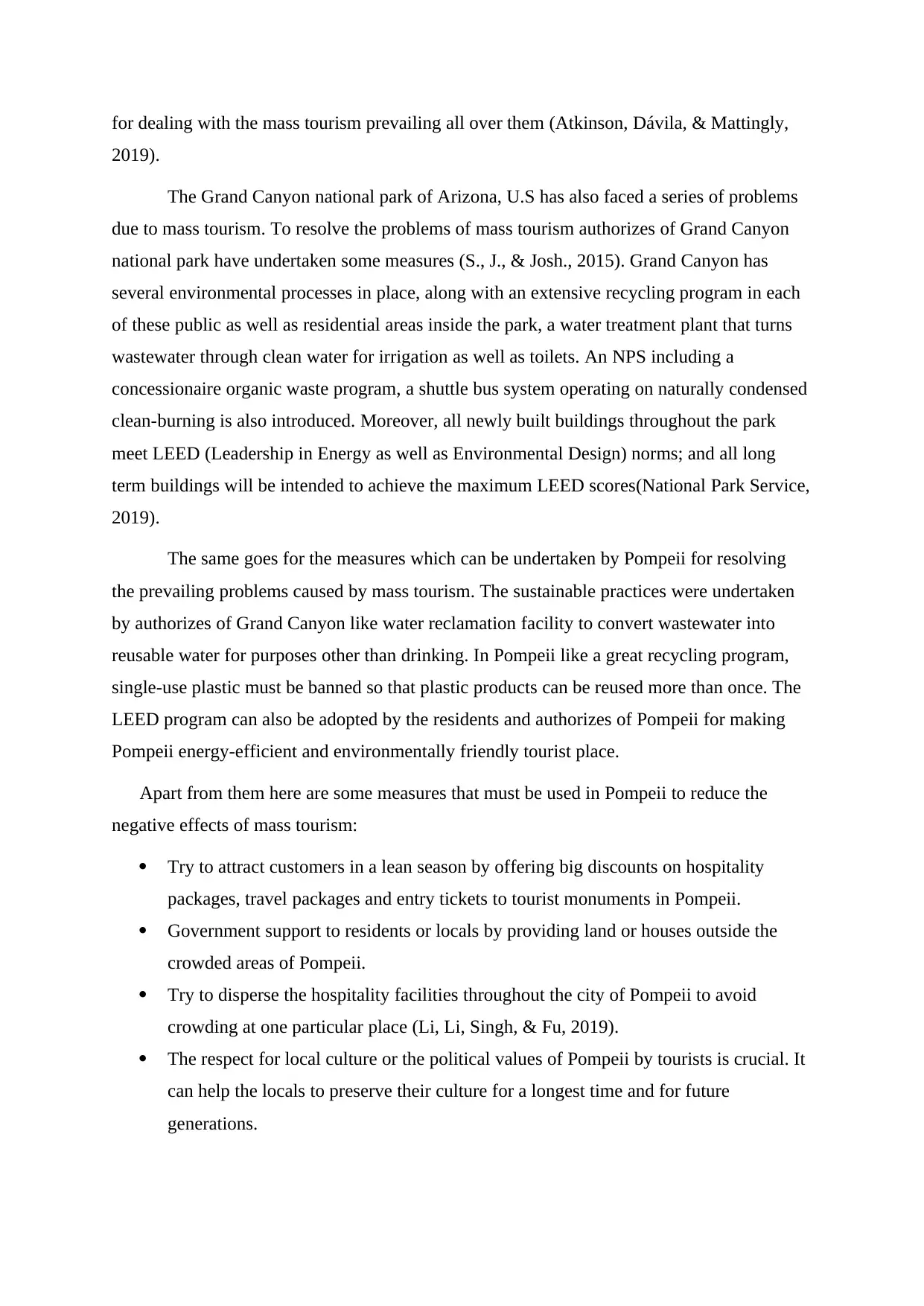
for dealing with the mass tourism prevailing all over them (Atkinson, Dávila, & Mattingly,
2019).
The Grand Canyon national park of Arizona, U.S has also faced a series of problems
due to mass tourism. To resolve the problems of mass tourism authorizes of Grand Canyon
national park have undertaken some measures (S., J., & Josh., 2015). Grand Canyon has
several environmental processes in place, along with an extensive recycling program in each
of these public as well as residential areas inside the park, a water treatment plant that turns
wastewater through clean water for irrigation as well as toilets. An NPS including a
concessionaire organic waste program, a shuttle bus system operating on naturally condensed
clean-burning is also introduced. Moreover, all newly built buildings throughout the park
meet LEED (Leadership in Energy as well as Environmental Design) norms; and all long
term buildings will be intended to achieve the maximum LEED scores(National Park Service,
2019).
The same goes for the measures which can be undertaken by Pompeii for resolving
the prevailing problems caused by mass tourism. The sustainable practices were undertaken
by authorizes of Grand Canyon like water reclamation facility to convert wastewater into
reusable water for purposes other than drinking. In Pompeii like a great recycling program,
single-use plastic must be banned so that plastic products can be reused more than once. The
LEED program can also be adopted by the residents and authorizes of Pompeii for making
Pompeii energy-efficient and environmentally friendly tourist place.
Apart from them here are some measures that must be used in Pompeii to reduce the
negative effects of mass tourism:
Try to attract customers in a lean season by offering big discounts on hospitality
packages, travel packages and entry tickets to tourist monuments in Pompeii.
Government support to residents or locals by providing land or houses outside the
crowded areas of Pompeii.
Try to disperse the hospitality facilities throughout the city of Pompeii to avoid
crowding at one particular place (Li, Li, Singh, & Fu, 2019).
The respect for local culture or the political values of Pompeii by tourists is crucial. It
can help the locals to preserve their culture for a longest time and for future
generations.
2019).
The Grand Canyon national park of Arizona, U.S has also faced a series of problems
due to mass tourism. To resolve the problems of mass tourism authorizes of Grand Canyon
national park have undertaken some measures (S., J., & Josh., 2015). Grand Canyon has
several environmental processes in place, along with an extensive recycling program in each
of these public as well as residential areas inside the park, a water treatment plant that turns
wastewater through clean water for irrigation as well as toilets. An NPS including a
concessionaire organic waste program, a shuttle bus system operating on naturally condensed
clean-burning is also introduced. Moreover, all newly built buildings throughout the park
meet LEED (Leadership in Energy as well as Environmental Design) norms; and all long
term buildings will be intended to achieve the maximum LEED scores(National Park Service,
2019).
The same goes for the measures which can be undertaken by Pompeii for resolving
the prevailing problems caused by mass tourism. The sustainable practices were undertaken
by authorizes of Grand Canyon like water reclamation facility to convert wastewater into
reusable water for purposes other than drinking. In Pompeii like a great recycling program,
single-use plastic must be banned so that plastic products can be reused more than once. The
LEED program can also be adopted by the residents and authorizes of Pompeii for making
Pompeii energy-efficient and environmentally friendly tourist place.
Apart from them here are some measures that must be used in Pompeii to reduce the
negative effects of mass tourism:
Try to attract customers in a lean season by offering big discounts on hospitality
packages, travel packages and entry tickets to tourist monuments in Pompeii.
Government support to residents or locals by providing land or houses outside the
crowded areas of Pompeii.
Try to disperse the hospitality facilities throughout the city of Pompeii to avoid
crowding at one particular place (Li, Li, Singh, & Fu, 2019).
The respect for local culture or the political values of Pompeii by tourists is crucial. It
can help the locals to preserve their culture for a longest time and for future
generations.
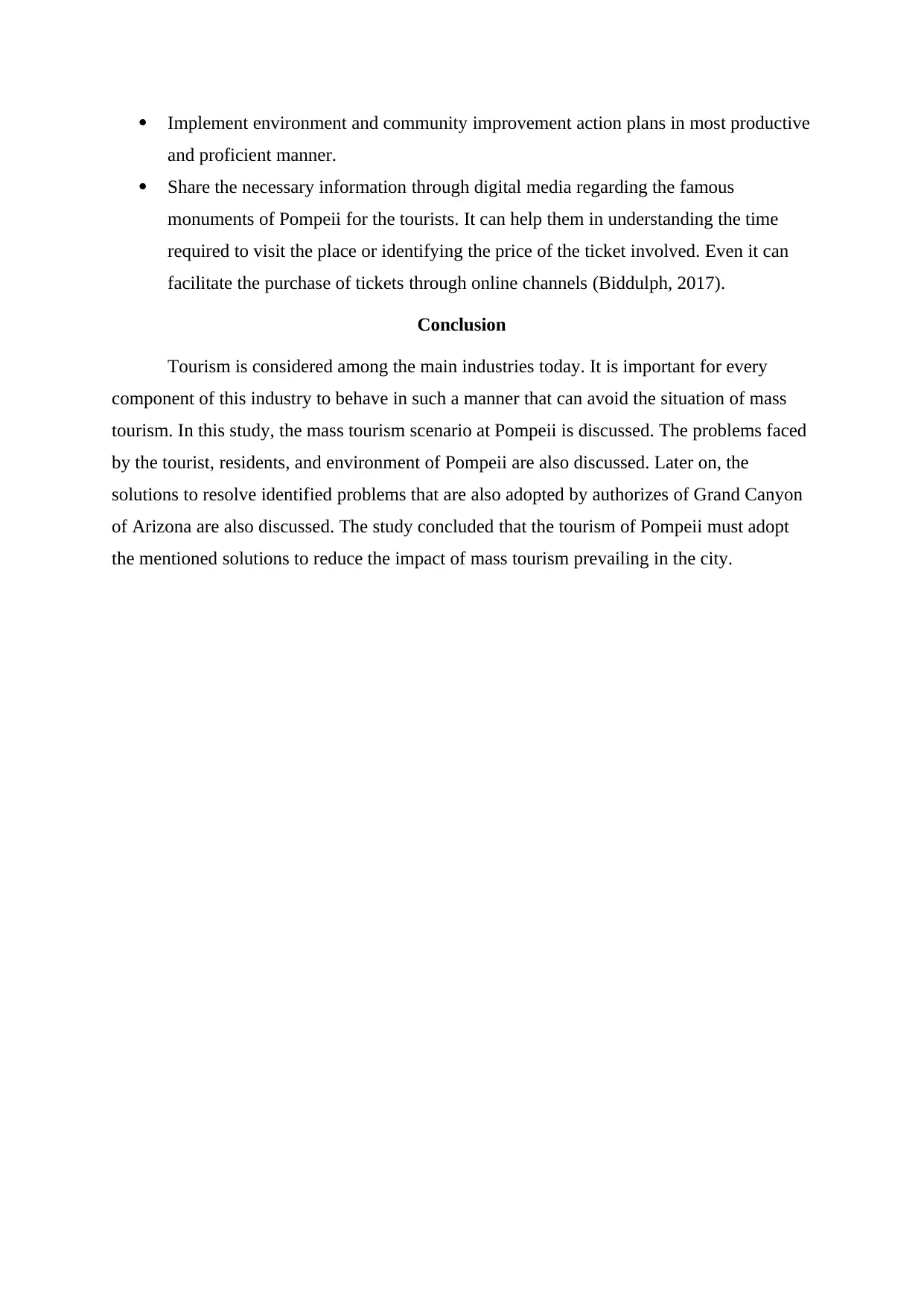
Implement environment and community improvement action plans in most productive
and proficient manner.
Share the necessary information through digital media regarding the famous
monuments of Pompeii for the tourists. It can help them in understanding the time
required to visit the place or identifying the price of the ticket involved. Even it can
facilitate the purchase of tickets through online channels (Biddulph, 2017).
Conclusion
Tourism is considered among the main industries today. It is important for every
component of this industry to behave in such a manner that can avoid the situation of mass
tourism. In this study, the mass tourism scenario at Pompeii is discussed. The problems faced
by the tourist, residents, and environment of Pompeii are also discussed. Later on, the
solutions to resolve identified problems that are also adopted by authorizes of Grand Canyon
of Arizona are also discussed. The study concluded that the tourism of Pompeii must adopt
the mentioned solutions to reduce the impact of mass tourism prevailing in the city.
and proficient manner.
Share the necessary information through digital media regarding the famous
monuments of Pompeii for the tourists. It can help them in understanding the time
required to visit the place or identifying the price of the ticket involved. Even it can
facilitate the purchase of tickets through online channels (Biddulph, 2017).
Conclusion
Tourism is considered among the main industries today. It is important for every
component of this industry to behave in such a manner that can avoid the situation of mass
tourism. In this study, the mass tourism scenario at Pompeii is discussed. The problems faced
by the tourist, residents, and environment of Pompeii are also discussed. Later on, the
solutions to resolve identified problems that are also adopted by authorizes of Grand Canyon
of Arizona are also discussed. The study concluded that the tourism of Pompeii must adopt
the mentioned solutions to reduce the impact of mass tourism prevailing in the city.
⊘ This is a preview!⊘
Do you want full access?
Subscribe today to unlock all pages.

Trusted by 1+ million students worldwide
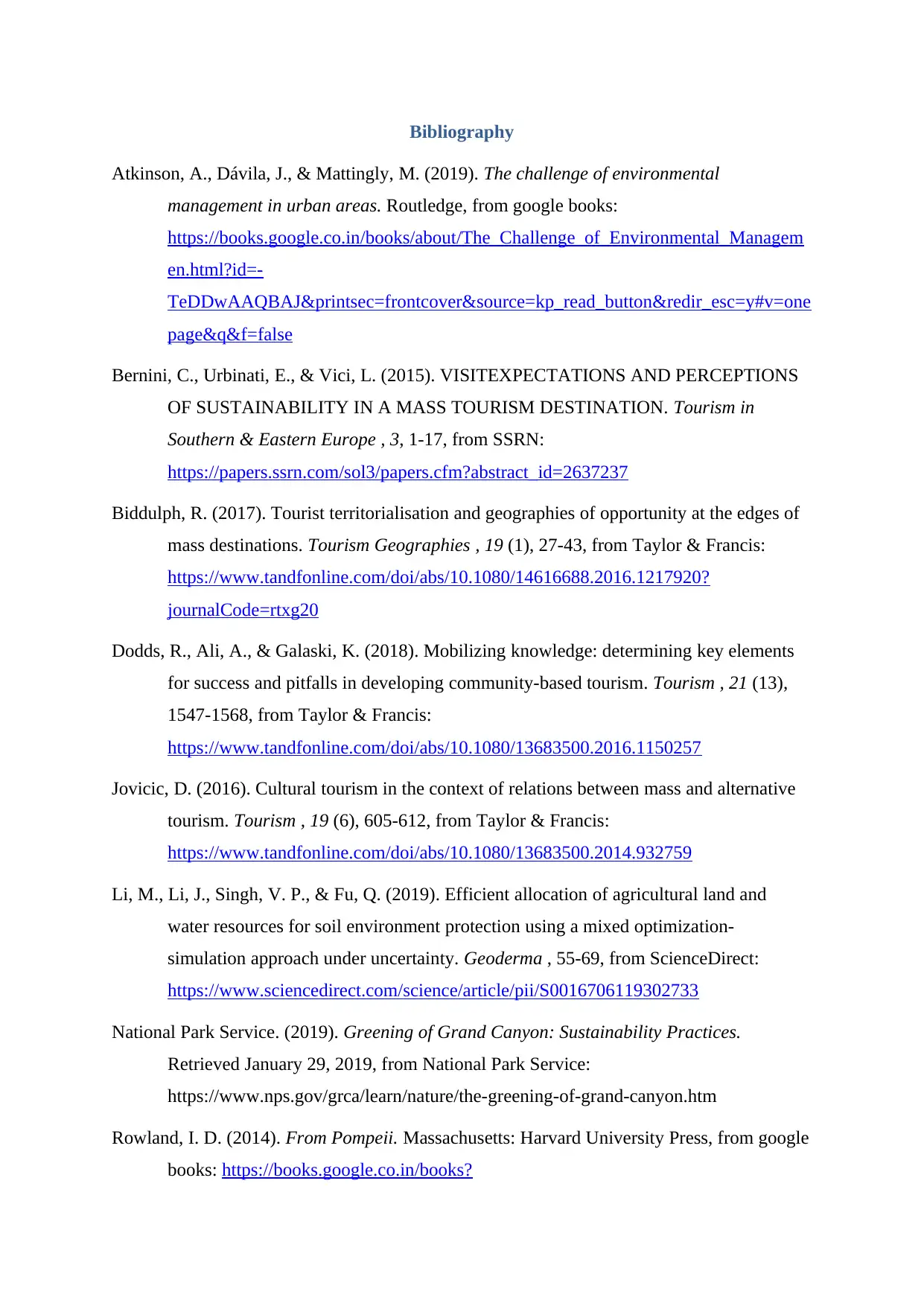
Bibliography
Atkinson, A., Dávila, J., & Mattingly, M. (2019). The challenge of environmental
management in urban areas. Routledge, from google books:
https://books.google.co.in/books/about/The_Challenge_of_Environmental_Managem
en.html?id=-
TeDDwAAQBAJ&printsec=frontcover&source=kp_read_button&redir_esc=y#v=one
page&q&f=false
Bernini, C., Urbinati, E., & Vici, L. (2015). VISITEXPECTATIONS AND PERCEPTIONS
OF SUSTAINABILITY IN A MASS TOURISM DESTINATION. Tourism in
Southern & Eastern Europe , 3, 1-17, from SSRN:
https://papers.ssrn.com/sol3/papers.cfm?abstract_id=2637237
Biddulph, R. (2017). Tourist territorialisation and geographies of opportunity at the edges of
mass destinations. Tourism Geographies , 19 (1), 27-43, from Taylor & Francis:
https://www.tandfonline.com/doi/abs/10.1080/14616688.2016.1217920?
journalCode=rtxg20
Dodds, R., Ali, A., & Galaski, K. (2018). Mobilizing knowledge: determining key elements
for success and pitfalls in developing community-based tourism. Tourism , 21 (13),
1547-1568, from Taylor & Francis:
https://www.tandfonline.com/doi/abs/10.1080/13683500.2016.1150257
Jovicic, D. (2016). Cultural tourism in the context of relations between mass and alternative
tourism. Tourism , 19 (6), 605-612, from Taylor & Francis:
https://www.tandfonline.com/doi/abs/10.1080/13683500.2014.932759
Li, M., Li, J., Singh, V. P., & Fu, Q. (2019). Efficient allocation of agricultural land and
water resources for soil environment protection using a mixed optimization-
simulation approach under uncertainty. Geoderma , 55-69, from ScienceDirect:
https://www.sciencedirect.com/science/article/pii/S0016706119302733
National Park Service. (2019). Greening of Grand Canyon: Sustainability Practices.
Retrieved January 29, 2019, from National Park Service:
https://www.nps.gov/grca/learn/nature/the-greening-of-grand-canyon.htm
Rowland, I. D. (2014). From Pompeii. Massachusetts: Harvard University Press, from google
books: https://books.google.co.in/books?
Atkinson, A., Dávila, J., & Mattingly, M. (2019). The challenge of environmental
management in urban areas. Routledge, from google books:
https://books.google.co.in/books/about/The_Challenge_of_Environmental_Managem
en.html?id=-
TeDDwAAQBAJ&printsec=frontcover&source=kp_read_button&redir_esc=y#v=one
page&q&f=false
Bernini, C., Urbinati, E., & Vici, L. (2015). VISITEXPECTATIONS AND PERCEPTIONS
OF SUSTAINABILITY IN A MASS TOURISM DESTINATION. Tourism in
Southern & Eastern Europe , 3, 1-17, from SSRN:
https://papers.ssrn.com/sol3/papers.cfm?abstract_id=2637237
Biddulph, R. (2017). Tourist territorialisation and geographies of opportunity at the edges of
mass destinations. Tourism Geographies , 19 (1), 27-43, from Taylor & Francis:
https://www.tandfonline.com/doi/abs/10.1080/14616688.2016.1217920?
journalCode=rtxg20
Dodds, R., Ali, A., & Galaski, K. (2018). Mobilizing knowledge: determining key elements
for success and pitfalls in developing community-based tourism. Tourism , 21 (13),
1547-1568, from Taylor & Francis:
https://www.tandfonline.com/doi/abs/10.1080/13683500.2016.1150257
Jovicic, D. (2016). Cultural tourism in the context of relations between mass and alternative
tourism. Tourism , 19 (6), 605-612, from Taylor & Francis:
https://www.tandfonline.com/doi/abs/10.1080/13683500.2014.932759
Li, M., Li, J., Singh, V. P., & Fu, Q. (2019). Efficient allocation of agricultural land and
water resources for soil environment protection using a mixed optimization-
simulation approach under uncertainty. Geoderma , 55-69, from ScienceDirect:
https://www.sciencedirect.com/science/article/pii/S0016706119302733
National Park Service. (2019). Greening of Grand Canyon: Sustainability Practices.
Retrieved January 29, 2019, from National Park Service:
https://www.nps.gov/grca/learn/nature/the-greening-of-grand-canyon.htm
Rowland, I. D. (2014). From Pompeii. Massachusetts: Harvard University Press, from google
books: https://books.google.co.in/books?
Paraphrase This Document
Need a fresh take? Get an instant paraphrase of this document with our AI Paraphraser
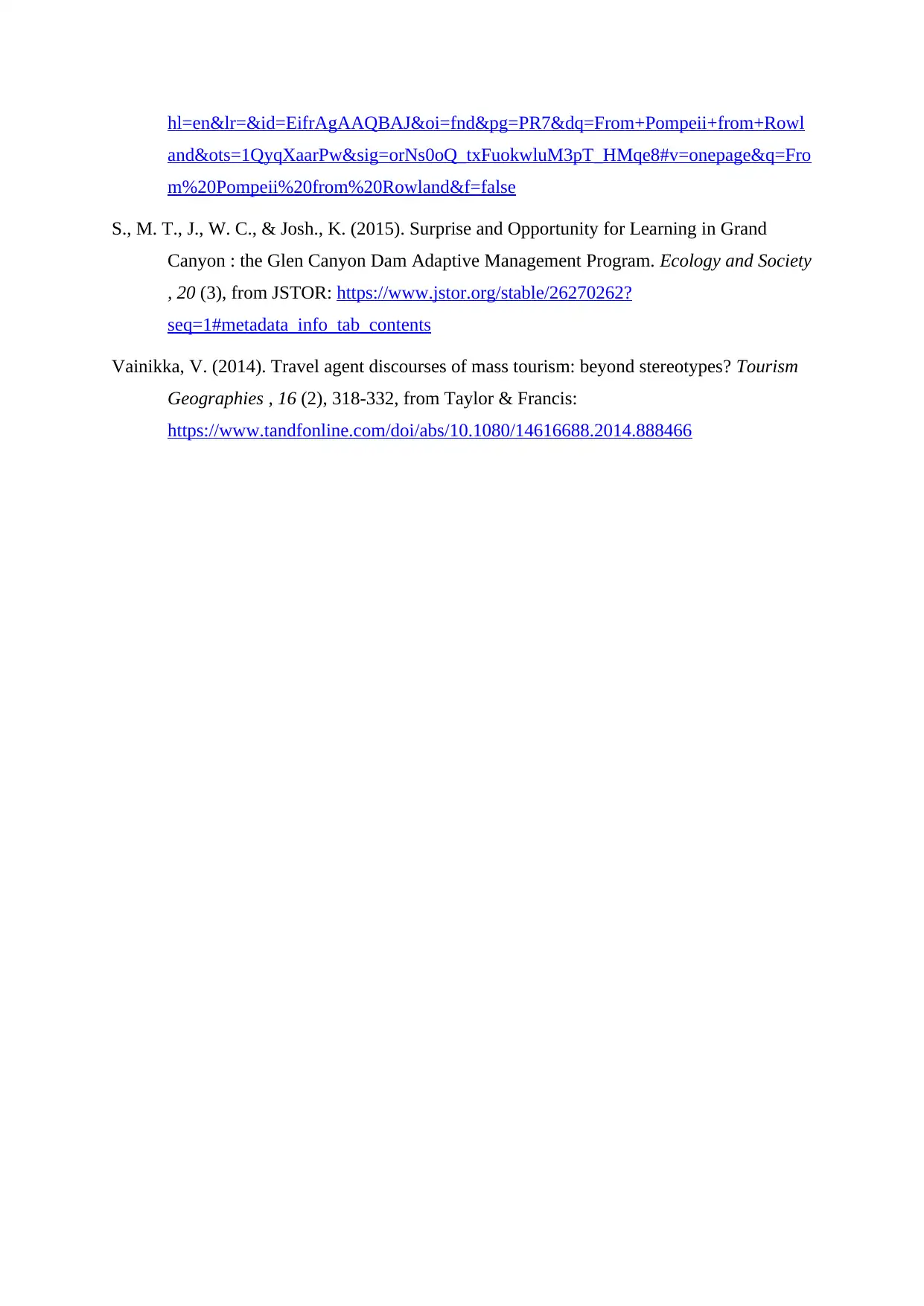
hl=en&lr=&id=EifrAgAAQBAJ&oi=fnd&pg=PR7&dq=From+Pompeii+from+Rowl
and&ots=1QyqXaarPw&sig=orNs0oQ_txFuokwluM3pT_HMqe8#v=onepage&q=Fro
m%20Pompeii%20from%20Rowland&f=false
S., M. T., J., W. C., & Josh., K. (2015). Surprise and Opportunity for Learning in Grand
Canyon : the Glen Canyon Dam Adaptive Management Program. Ecology and Society
, 20 (3), from JSTOR: https://www.jstor.org/stable/26270262?
seq=1#metadata_info_tab_contents
Vainikka, V. (2014). Travel agent discourses of mass tourism: beyond stereotypes? Tourism
Geographies , 16 (2), 318-332, from Taylor & Francis:
https://www.tandfonline.com/doi/abs/10.1080/14616688.2014.888466
and&ots=1QyqXaarPw&sig=orNs0oQ_txFuokwluM3pT_HMqe8#v=onepage&q=Fro
m%20Pompeii%20from%20Rowland&f=false
S., M. T., J., W. C., & Josh., K. (2015). Surprise and Opportunity for Learning in Grand
Canyon : the Glen Canyon Dam Adaptive Management Program. Ecology and Society
, 20 (3), from JSTOR: https://www.jstor.org/stable/26270262?
seq=1#metadata_info_tab_contents
Vainikka, V. (2014). Travel agent discourses of mass tourism: beyond stereotypes? Tourism
Geographies , 16 (2), 318-332, from Taylor & Francis:
https://www.tandfonline.com/doi/abs/10.1080/14616688.2014.888466
1 out of 8
Related Documents
Your All-in-One AI-Powered Toolkit for Academic Success.
+13062052269
info@desklib.com
Available 24*7 on WhatsApp / Email
![[object Object]](/_next/static/media/star-bottom.7253800d.svg)
Unlock your academic potential
Copyright © 2020–2025 A2Z Services. All Rights Reserved. Developed and managed by ZUCOL.





